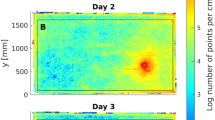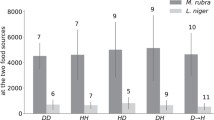Abstract
Nest site quality can affect survival and reproduction, and thus many animals have evolved behaviors which facilitate nest site assessment and selection. Ants of the genus Temnothorax have been shown to include an array of nest site attributes when choosing such a site. Here, we show that they also include traits of the habitat surrounding nest sites. In particular, we found that during emigration, ants preferred to move to nests located close to a previously explored food-rich area. We also determined that scent markings played a role in this choice and that scouts and transporting ants may have tracked scent marks laid in foraging, and this behavior could have biased emigration toward nests located near previously foraged areas. These results indicate that pheromones play a bigger role in Temnothorax foraging and decision making in emigration than previously thought. Overall, this work provides new insights into the mechanisms involved in habitat selection in ants and contributes to our understanding of collective behavior in social insects in general.

Similar content being viewed by others
References
Adams E.S. 1994. Territory defense by the ant Azteca trigona - maintenance of an arboreal ant mosaic. Oecologia 97: 202-208
Banschbach V.S. and Herbers J.M. 1999. Nest movements and population spatial structure of the forest ant Myrmica punctiventris (Hymenoptera: Formicidae). Ann. Entomol. Soc. Am. 92: 414-423
Beckers R., Deneubourg J.L. and Goss S. 1992. Trail laying behavior during food recruitment in the ant Lasius niger. Insect. Soc. 39: 59-72
Burke D.M. and Nol E. 1998. Influences of food abundance, nest-site habitat, and forest fragmentation on breeding ovenbirds. The Auk 115: 96-104
Cody M.L. 1974. Optimization in ecology: natural selection produces optimal results unless constrained by history or by competing goals. Science 183: 1156-1164
Davidson D.W. 1997. The role of resource imbalances in the evolutionary ecology of tropical arboreal ants. Biol. J. Linn. Soc. 61: 153-181
Depickère S., Fresneau D., Detrain C. and Deneubourg J.L. 2004. Marking as a decision factor in the choice of a new resting site in Lasius niger. Insect. Soc. 51: 243-246
Fewell J.H., Harrison J.F., Lighton J.R.B. and Breed M.D. 1996. Foraging energetics of the ant, Paraponera clavata. Oecologia 105: 419-427
Foitzik S., Backus V.L., Trindl A. and Herbers J.M. 2004. Ecology of Leptothorax ants: impact of food, nest sites, and social parasites. Behav. Ecol. Sociobiol. 55: 484-493
Forsman J.T., Hjernquist M.B., Taipale J. and Gustafsson L. 2008. Competitor density cues for habitat quality facilitating habitat selection and investment decisions. Behav. Ecol. 19: 539-545
Franks N.R., Mallon E.B., Bray H.E., Hamilton M.J. and Mischler T.C. 2003. Strategies for choosing between alternatives with different attributes: exemplified by house-hunting ants. Anim. Behav. 65: 215-223
Franks N.R., Hooper J., Webb C. and Dornhaus A. 2005. Tomb evaders: house-hunting hygiene in ants. Biol. Lett. 1: 190-192
Franks N.R. and Richardson T. 2006. Teaching in tandem-running ants. Nature 439: 153-153
Franks N.R., Dornhaus A., Best C.S. and Jones E.L. 2006a. Decision making by small and large house-hunting ant colonies: one size fits all. Anim. Behav. 72: 611-616
Franks N.R., Dornhaus A., Metherell B.G., Nelson T.R., Lanfear S.A.J. and Symes W.S. 2006b. Not everything that counts can be counted: ants use multiple metrics for a single nest trait. Proc. R. Soc. Lond. B Biol. Sci. 273: 165-169
Franks N.R., Dornhaus A., Hitchcock G., Guillem R., Hooper J. and Webb C. 2007a. Avoidance of conspecific colonies during nest choice by ants. Anim. Behav. 73: 525-534
Franks N.R., Hooper J.W., Dornhaus A., Aukett P.J., Hayward A.L. and Berghoff S.M. 2007b. Reconnaissance and latent learning in ants. Proc. R. Soc. Lond. B Biol. Sci. 274: 1505-1509
Gordon D.M. 1992. Nest relocation in harvester ants. Ann. Entomol. Soc. Am. 85: 44-47
Gustafsson L. 1987. Interspecific competition lowers fitness in collared flycatchers Ficedula albicollis - an experimental demonstration. Ecology 68: 291-296
Herbers J.M., Adamowicz S.C. and Helms S.D. 1985. Seasonal-changes in social organization of Aphaenogaster rudis (Hymenoptera, Formicidae). Sociobiology 10: 1-15
Hölldobler B. 1976. Tournaments and slavery in a desert ant. Science 192: 912-914
Hölldobler B. and Wilson E.O. 1977. Weaver ants - social establishment and maintenance of territory. Science 195: 900-902
Hölldobler B. and Wilson E.O. 1990. The Ants. Belknap Press of Harvard University Press, Cambridge, MA
Holway D.A. and Case T.J. 2000. Mechanisms of dispersed central-place foraging in polydomous colonies of the Argentine ant. Anim. Behav. 59: 433-441
Kleineidam C.J., Ruchty M., Casero-Montes Z.A. and Roces F. 2007. Thermal radiation as a learned orientation cue in leaf-cutting ants (Atta vollenweideri). J. Insect Physiol. 53: 478-487
Klotz J.H. and Reid B.L. 1993. Nocturnal orientation in the black carpenter ant Camponotus pennsylvanicus (DeGeer) (Hymenoptera: Formicidae). Insect. Soc. 40: 95-106
Krebs J.R. and Davies N.B. 1993. An Introduction To Behavioural Ecology. Blackwell Scientific Publications, Oxford
Lenoir A., Depickère S., Devers S., Christides J.P. and Detrain C. 2009. Hydrocarbons in the ant Lasius niger: from the cuticle to the nest and home range marking. J. Chem. Ecol. 35: 913-921
Mallon E.B. and Franks N.R. 2000. Ants estimate area using Buffon’s needle. Proc. R. Soc. Lond. B Biol. Sci. 267: 765-770
Maschwitz U. and Hanel H. 1985. The migrating herdsman Dolichoderus (Diabolus) cuspidatus - an ant with a novel mode of life. Behav. Ecol. Sociobiol. 17: 171-184
McGlynn T.P., Hoover J.R., Jasper G.S., Kelly M.S., Polis A.M., Spangler C.M. and Watson B.J. 2002. Resource heterogeneity affects demography of the Costa Rican ant Aphaenogaster araneoides. J. Trop. Ecol. 18: 231-244
McGlynn T.P. 2006. Ants on the move: Resource limitation of a litter-nesting ant community in Costa Rica. Biotropica 38: 419-427
McGlynn T.P. 2007. Serial monodomy in ants: an antipredator strategy? Ecol. Entomol. 32: 621-626
McIver J.D. 1991. Dispersed central place foraging in Australian meat ants. Insect. Soc. 38: 129-137
Morgan E.D. 2009. Trail pheromones of ants. Physiol. Entomol. 34: 1-17
Morris D.W. 1987. Tests of density-dependent habitat selection in a patchy environment. Ecol. Monogr. 57: 269-281
Morris D.W. 1989. Density-dependent habitat selection - testing the theory with fitness data. Evol. Ecol. 3: 80-94
Nielsen M.G. 2001. Energetic cost of foraging in the ant Rhytidoponera aurata in tropical Australia. Physiol. Entomol. 26: 248-253
Oster G.F. and Wilson E.O. 1978. Caste and Ecology in the Social Insects. Princeton University Press, Princeton, NJ
Partridge L.W., Partridge K.A. and Franks N.R. 1997. Field survey of a monogynous leptothoracine ant (Hymenoptera, Formicidae): Evidence of seasonal polydomy? Insect. Soc. 44: 75-83
Pratt S.C., Mallon E.B., Sumpter D.J.T. and Franks N.R. 2002. Quorum sensing, recruitment, and collective decision-making during colony emigration by the ant Leptothorax albipennis. Behav. Ecol. Sociobiol. 52: 117-127
Pratt S.C. 2005. Quorum sensing by encounter rates in the ant Temnothorax albipennis. Behav. Ecol. 16: 488-496
Pratt S.C. 2008. Efficiency and regulation of recruitment during colony emigration by the ant Temnothorax curvispinosus. Behav. Ecol. Sociobiol. 62: 1369-1376
Richardson T.O., Sleeman P.A., McNamara J.M., Houston A.I. and Franks N.R. 2007. Teaching with evaluation in ants. Curr. Biol. 17: 1520-1526
Riveros A.J. and Srygley R.B. 2008. Do leafcutter ants, Atta colombica, orient their path-integrated home vector with a magnetic compass? Anim. Behav. 75: 1273-1281
Rüppell O., Heinze J. and Hölldobler B. 1998. Size-dimorphism in the queens of the North American ant Leptothorax rugatulus (Emery). Insect. Soc. 45: 67-77
Rüppell O. and Kirkman R.W. 2005. Extraordinary starvation resistance in Temnothorax rugatulus (Hymenoptera, Formicidae) colonies: Demography and adaptive behavior. Insect. Soc. 52: 282-290
Sergio F., Pedrini P. and Marchesi L. 2003. Adaptive selection of foraging and nesting habitat by black kites (Milvus migrans) and its implications for conservation: A multi-scale approach. Biol. Conserv. 112: 351-362
Sergio F. and Newton I. 2003. Occupancy as a measure of territory quality. J. Anim. Ecol. 72: 857-865
Sherman L.J. 1984. The effects of patchy food availability on nest-site selection and movement patterns of reproductively active female meadow Voles Microtus pennsylvanicus. Holarctic Ecol. 7: 294-299
Shima J.S. and Osenberg C.W. 2003. Cryptic density dependence: Effects of covariation between density and site quality in reef fish. Ecology 84: 46-52
Sinervo B. and DeNardo D.F. 1996. Costs of reproduction in the wild: Path analysis of natural selection and experimental tests of causation. Evolution 50: 1299-1313
Smallwood J. and Culver D.C. 1979. Colony movements of some North-American ants. J. Anim. Ecol. 48: 373-382
Smallwood J. 1982. Nest relocations in ants. Insect. Soc. 29: 138-147
Tentschert J., Bestmann H.J., Hölldobler B. and Heinze J. 2000. 2,3-dimethyl-5-(2-methylpropyl)pyrazin, a trail pheromone component of Eutetramorium mocquerysi Emery (1899) (Hymenoptera: Formicidae). Naturwissenschaften 87: 377-380
Torres-Contreras H. and Vasquez R.A. 2004. A field experiment on the influence of load transportation and patch distance on the locomotion velocity of Dorymyrmex goetschi (Hymenoptera, Formicidae). Insect. Soc. 51: 265-270
van Wilgenburg E. and Elgar M.A. 2007. Colony structure and spatial distribution of food resources in the polydomous meat ant Iridomyrmex purpureus. Insect. Soc. 54: 5-10
Wilson E.O. 1975. Enemy specification in alarm-recruitment system of an ant. Science 190: 798-800
Witte V. and Maschwitz U. 2002. Coordination of raiding and emigration in the ponerine army ant Leptogenys distinguenda (Hymenoptera: Formicidae: Ponerinae): A signal analysis. J. Insect. Behav. 15: 195-217
Yuan H.W., Burt D.B., Wang L.P., Chang W.L., Wang M.K., Chiou C.R. and Ding T.S. 2006. Colony site choice of blue-tailed bee-eaters: influences of soil, vegetation, and water quality. J. Nat. Hist. 40: 485-493
Acknowledgments
We thank Margaret Couvillon, Jenny Jandt, Nhi Duong and the two anonymous reviewers for providing helpful comments on an earlier version of this manuscript. The Department of Ecology and Evolutionary Biology at the University of Arizona provided funding for this work.
Author information
Authors and Affiliations
Corresponding author
Rights and permissions
About this article
Cite this article
Cao, T.T., Dornhaus, A. Ants use pheromone markings in emigrations to move closer to food-rich areas. Insect. Soc. 59, 87–92 (2012). https://doi.org/10.1007/s00040-011-0192-8
Received:
Revised:
Accepted:
Published:
Issue Date:
DOI: https://doi.org/10.1007/s00040-011-0192-8




